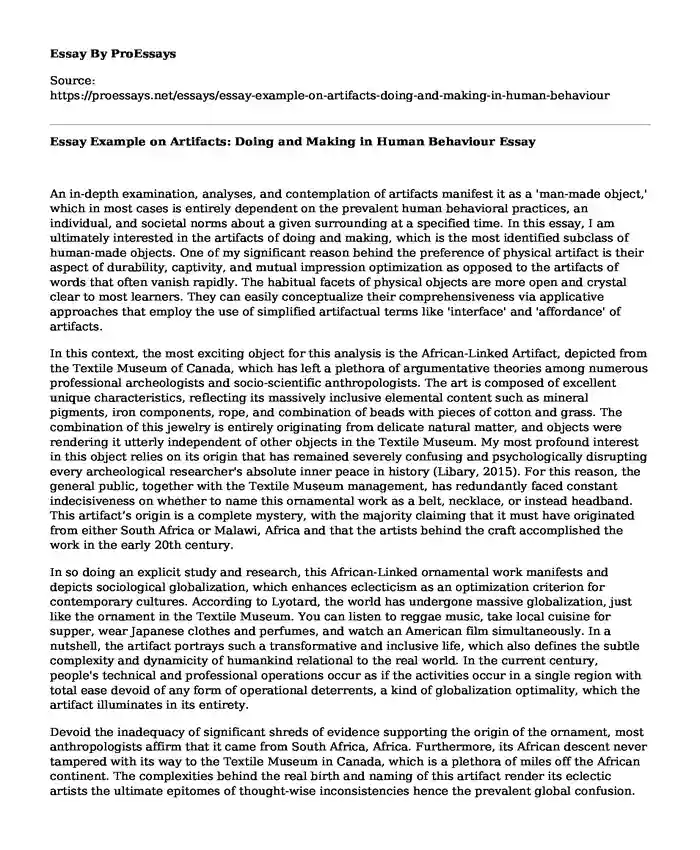An in-depth examination, analyses, and contemplation of artifacts manifest it as a 'man-made object,' which in most cases is entirely dependent on the prevalent human behavioral practices, an individual, and societal norms about a given surrounding at a specified time. In this essay, I am ultimately interested in the artifacts of doing and making, which is the most identified subclass of human-made objects. One of my significant reason behind the preference of physical artifact is their aspect of durability, captivity, and mutual impression optimization as opposed to the artifacts of words that often vanish rapidly. The habitual facets of physical objects are more open and crystal clear to most learners. They can easily conceptualize their comprehensiveness via applicative approaches that employ the use of simplified artifactual terms like 'interface' and 'affordance' of artifacts.
In this context, the most exciting object for this analysis is the African-Linked Artifact, depicted from the Textile Museum of Canada, which has left a plethora of argumentative theories among numerous professional archeologists and socio-scientific anthropologists. The art is composed of excellent unique characteristics, reflecting its massively inclusive elemental content such as mineral pigments, iron components, rope, and combination of beads with pieces of cotton and grass. The combination of this jewelry is entirely originating from delicate natural matter, and objects were rendering it utterly independent of other objects in the Textile Museum. My most profound interest in this object relies on its origin that has remained severely confusing and psychologically disrupting every archeological researcher's absolute inner peace in history (Libary, 2015). For this reason, the general public, together with the Textile Museum management, has redundantly faced constant indecisiveness on whether to name this ornamental work as a belt, necklace, or instead headband. This artifact’s origin is a complete mystery, with the majority claiming that it must have originated from either South Africa or Malawi, Africa and that the artists behind the craft accomplished the work in the early 20th century.
In so doing an explicit study and research, this African-Linked ornamental work manifests and depicts sociological globalization, which enhances eclecticism as an optimization criterion for contemporary cultures. According to Lyotard, the world has undergone massive globalization, just like the ornament in the Textile Museum. You can listen to reggae music, take local cuisine for supper, wear Japanese clothes and perfumes, and watch an American film simultaneously. In a nutshell, the artifact portrays such a transformative and inclusive life, which also defines the subtle complexity and dynamicity of humankind relational to the real world. In the current century, people's technical and professional operations occur as if the activities occur in a single region with total ease devoid of any form of operational deterrents, a kind of globalization optimality, which the artifact illuminates in its entirety.
Devoid the inadequacy of significant shreds of evidence supporting the origin of the ornament, most anthropologists affirm that it came from South Africa, Africa. Furthermore, its African descent never tampered with its way to the Textile Museum in Canada, which is a plethora of miles off the African continent. The complexities behind the real birth and naming of this artifact render its eclectic artists the ultimate epitomes of thought-wise inconsistencies hence the prevalent global confusion. The artists were utterly unable to make up their minds properly amid innovative development, creative designation, and inventive production of the ornament, in addition to the loss of focus on the ornamental’s ultimate applications (Emma Quin, 2018). Instead, the makers based their total concentration on its elemental visual value as jewelry, a particular context of optimal eclecticism. Additionally, the use of rope, beads, minerals, and wire on this sterling piece of art, whose historical sources were Egypt, Libya, Zambia, and South Africa, respectively, symbolize diversity and precisely globalization.
Conclusion
In a nutshell, the artifact's techniques appear to be known to specific people who come from particular parts across the globe and their raw material, which are linked to different parts of the world.
Reference
Emma Quin, M. A. (2018). The Textile Museum of Canada: Aims to Inspire People on The Human Experience through Textiles. Journal of the Canadian Museum of Carpets and Textiles. https://textilemuseum.ca/about-the-museum/#:~:text=The%20Textile%20Museum%20of%20Canada,the%20human%20experience%20through%20textiles.&text=The%20Museum%20ignites%20creativity%2C%20inspires,engagement%20with%20contemporary%20art%20practices.
Cite this page
Essay Example on Artifacts: Doing and Making in Human Behaviour. (2023, Sep 27). Retrieved from https://proessays.net/essays/essay-example-on-artifacts-doing-and-making-in-human-behaviour
If you are the original author of this essay and no longer wish to have it published on the ProEssays website, please click below to request its removal:
- Trainer Manual: Stress Management
- How 9/11 Changed the Electrical Industry? - Essay Sample
- Essay Sample on Gender and Colonialism: Corrie Decker - History
- Essay Sample on Exploring the Dark History of Slavery in Africa & America
- The Notorious Serial Killer Ted Bundy: 30 Confirmed Murders and Beyond - Essay Sample
- Intersex Individuals Through History: An Exploration - Essay Sample
- Paper Example on Exploring Experiential Marketing, Consumer Purchase Behaviour, Value, and Positivism







